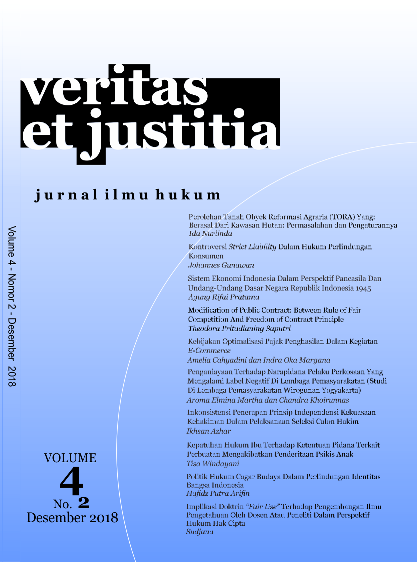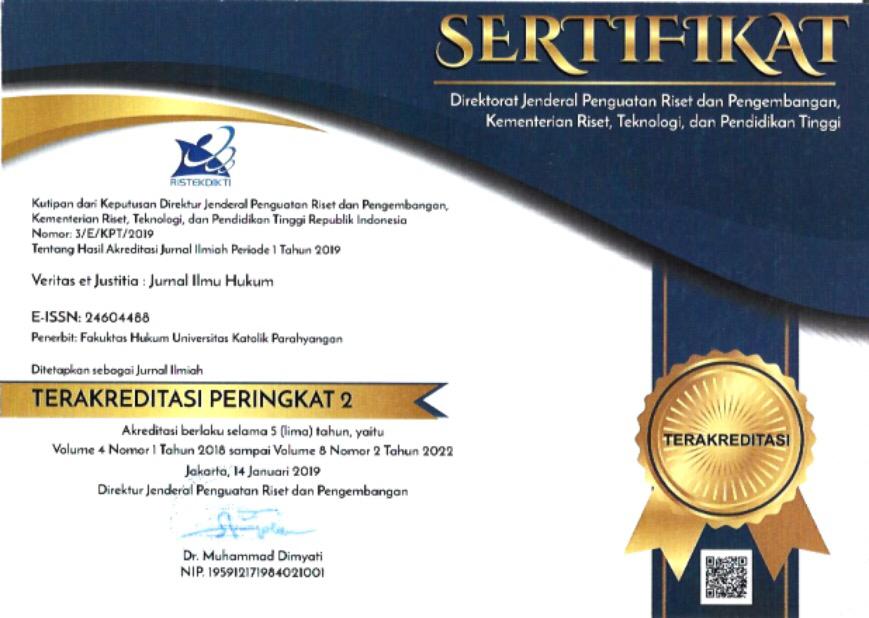INKONSISTENSI PENERAPAN PRINSIP INDEPENDENSI KEKUASAAN KEHAKIMAN DALAM PELAKSANAAN SELEKSI CALON HAKIM
DOI:
https://doi.org/10.25123/vej.v4i2.3070Abstrak
The general public in 2017 hotly debated the implemented selection process of Judges. The focus is on the issue of government involvement in the selection process which potentially jeopardize the judiciary’s independence. In discussing this particular issue, the author uses a juridical normative or dogmatic approach and other data is collected by the use of library research . In addition, the author also compares the existing policy and rules/regulation concerning judge selection from different government’ era (the Old & New Order). A number of conclusions can be drawn from this comparison, i.e. that during the Old dan New Order Government, the judiciary was never considered independent. The government on a regular basis intervene in the selection process, appointment and placement of judges and have a strong say in their professional carrer path. In contrast, only after the fall of the New Order Government, did the Judiciary enjoy independence which is guaranteed by virtue of Law 35/1999 and the 1945 Constitution (amended version). Unfortunately though the Supreme Court decide to bring back in the government in the selection process and in doing that jeopardize the judicary’s independence.
Referensi
Buku-Buku
Departemen Pendidikan Nasional, Kamus Besar Bahasa Indonesia, Edisi Ketiga, Jakarta: Balai Pustaka, 2005.
Djohansyah, Reformasi Mahkamah Agung Menuju Independensi Kekuasaan Kehakiman, Jakarta: Kesaint Blanc, 2008.
Garner, Black Law Dictionary, seventh edition, USA: West Group, 1999.
Ismail Suny, Pembagian Kekuasaan Negara, Jakarta: Aksara Baru,1978.
Luu Tien Dung. Judicial Indepencdence In Transitional Countries, Oslo: UNDP Democratic Governance Fellowship Programme, 2003.
Rikardo Simamarta, Politik Hukum Peradilan di Indonesia Masa Orde Baru dan Reformasi. Dalam Bunga Rampai Putih Hitam Pengadilan Khusus. (Jakarta: Komisi Yudisial Republik Indonesia).
Suparman Marzuki. Kewenangan Komisi Yudisial dalam Konteks Politik Hukum Kekuasaan Kehakiman. Dalam Bunga Rampai Putih Hitam Pengadilan Khusus. (Jakarta: Komisi Yudisial Republik Indonesia, 2013).
Jurnal, Majalah, dan Surat Kabar
Aidul Fitriciada A. Kekuasaan Kehakiman Yang Merdeka Dan Bertanggung Jawab Di Mahkamah Konstitusi: Upaya Menemukan Keseimbangan. Jurnal Jurisprudence Vol. 2, Nomor 1 Maret, 2005.
Nur Agus Susanto. Independensi Kekuasaan Kehakiman dan Efektifitas Sanksi Untuk Kasus Hakim Penerima Suap. Jurnal Yudisial Vol-IV Nomor 01. April 2013.
Susi Dwi Harijanti. Membangun Independensi dan Akuntabilitas Hakim serta MA. Jurnal Panterei Vol. I Nomor 3. Februari 2009.
Situs Internet
Amzulian Rifai. Merekrut Para Wakil Tuhan. http://koran-sindo.com/page/news/2017-07-10/1/2/index.php, diunduh terakhir tanggal 21 Mei 2018.
Sirajuddin. Format Kekuasaan Kehakiman Dalam Perubahan Lanjutan Konstitusi. http://ejournal.umm.ac.id/index.php/legality/article/viewFile/1537/1639_umm_scientific_journal.pdf, diunduh terakhir tahun 2016.
Hakim Agung 'Membonsai' KY, KHN: Seleksi calon hakim Ala MA Rawan Suap dan KKN. https://news.detik.com/berita/2883943/hakim-agung-membonsai-ky-khn-seleksi-hakim-ala-ma-rawan-suap-dan-kkn, diunduh terakhir tahun 2017.
Membaca Ulang Blue Print MA, Menyelamatkan Reformasi Indonesia, https://news.detik.com/berita/2885009/membaca-ulang-blue-print-ma-menyelamatkan-reformasi-indonesia, diunduh terakhir 2017.
Peraturan Perundang-Undangan dan Perjanjian Internasional
International Commision of Jurist. International Principles on the Independence and Accountability of Judges, Lawyes, and Prosecutors , London: Foreign & Commonwealth Office London.
Undang-Undang R.I No. 49 Tahun 2009, Perubahan Kedua Atas Undang-Undang Nomor 2 Tahun 1986 Tentang Peradilan Umum, L.N.R.I. Tahun 2009 No. 5077, Penjelasan Umum.
##submission.downloads##
Diterbitkan
Terbitan
Bagian
Lisensi
Authors who publish with this journal agree to the following terms:
Authors retain copyright and grant the journal right of first publication with the work simultaneously licensed under a Creative Commons Attribution License that allows others to share the work with an acknowledgement of the work's authorship and initial publication in this journal.
Authors are able to enter into separate, additional contractual arrangements for the non-exclusive distribution of the journal's published version of the work (e.g., post it to an institutional repository or publish it in a book), with an acknowledgement of its initial publication in this journal.
Authors are permitted and encouraged to post their work online (e.g., in institutional repositories or on their website) prior to and during the submission process, as it can lead to productive exchanges, as well as earlier and greater citation of published work.
The Journal allow the author(s) to hold the copyright and to retian publishing rights without restrictions.










